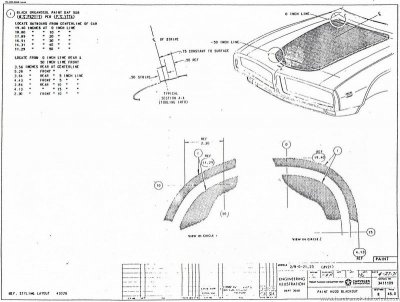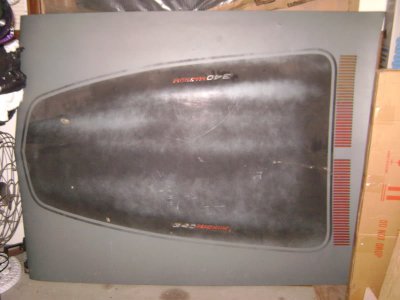You are using an out of date browser. It may not display this or other websites correctly.
You should upgrade or use an alternative browser.
You should upgrade or use an alternative browser.
Does ANYBODY know how to translate this hood detail diagram into human?
- Thread starter 318 Six Pack
- Start date
challenger6pak
Well-Known Member
Do an internet image search for 72 Charger Rallye. It will make sence after seeing a few pics.
RGAZ
Well-Known Member
This 1972 hood blackout instruction/diagram is great info for those of you who are paint gurus. However, us mere mortals could use a translation.
What are you struggling with? This is using standard drafting methods that are the same since the 50's.
I'll take a shot at the basics.
1. On the hood there is an X with a "C L" overlapping each other to the top. That means "center line" and is the exact center of the hood/shape. All dimensions will be from the Center line.
2. There are two circles numbers 1 and 2. The zoomed in diagrams show exactly what is in circle 1 and 2.
3. The 1 in a circle is called a "balloon" and it is referring you to the details in text in the upper right. This detail EXACTLY tells you where the stripe curves are and changes in shape. This is outstanding detail! They refer to the Zero inch line and 50 inch line so you can be perfect.
4. The zero inch line and 50 inch line show you the exact length and it is referred to in the ballon pictures. That allows you to measure to the exact curvature points and duplicate the shape.
5. Any dimension noted that has a "ref" next to it means that it does not have a tolerance and should be within capability of the other controlled dimensions. Its basically the leftovers. Use the non-ref dimensions to determine the exact location. In general, if the dimension has two decimal places, its plus or minus .01 or .02 (depending on the internal mopar guidelines)
6. The section A-A area is detailing out the very tip of the shape. It is a tooling reference for use in the factory.
7. The boxes on the lower right are kinda cool. Approved April 27 1971 and revised twice. If you could get the styling layout noted in the lower left corner that would help. It might have additional dimensional info.
Identification of the exact location of the zero inch line could be tough from the drawing, but that is the origin of all measurements.
I gotta ask, this is a proprietary Engineering Drawing owned by chrysler. Where did you get it? If you had a high resolution copy, I'd love it PM'ed to me.
Randy
318 Six Pack
Well-Known Member
I've seen many of those, was asking how the diagram actually translates to laying them out.
- - - Updated - - -
What are you struggling with? This is using standard drafting methods that are the same since the 50's.
I'll take a shot at the basics.
1. On the hood there is an X with a "C L" overlapping each other to the top. That means "center line" and is the exact center of the hood/shape. All dimensions will be from the Center line.
2. There are two circles numbers 1 and 2. The zoomed in diagrams show exactly what is in circle 1 and 2.
3. The 1 in a circle is called a "balloon" and it is referring you to the details in text in the upper right. This detail EXACTLY tells you where the stripe curves are and changes in shape. This is outstanding detail! They refer to the Zero inch line and 50 inch line so you can be perfect.
4. The zero inch line and 50 inch line show you the exact length and it is referred to in the ballon pictures. That allows you to measure to the exact curvature points and duplicate the shape.
5. Any dimension noted that has a "ref" next to it means that it does not have a tolerance and should be within capability of the other controlled dimensions. Its basically the leftovers. Use the non-ref dimensions to determine the exact location. In general, if the dimension has two decimal places, its plus or minus .01 or .02 (depending on the internal mopar guidelines)
6. The section A-A area is detailing out the very tip of the shape. It is a tooling reference for use in the factory.
7. The boxes on the lower right are kinda cool. Approved April 27 1971 and revised twice. If you could get the styling layout noted in the lower left corner that would help. It might have additional dimensional info.
Identification of the exact location of the zero inch line could be tough from the drawing, but that is the origin of all measurements.
I gotta ask, this is a proprietary Engineering Drawing owned by chrysler. Where did you get it? If you had a high resolution copy, I'd love it PM'ed to me.
Randy
Now THAT was helpful. I haven't had a drafting class since Soph. HS. Sounds like this might translate into instruction for a CNC machine to make a mask.
I found the diagram here, it was a pretty easy search on The Googles: http://board.moparts.org/ubbthreads/upload2/6923787-72ChargerHoodBlackout.jpg
- - - Updated - - -
The most helpful picture I've seen of a painted hood was this one, but it is labeled a 1973 hood rather than 1972:
http://img.photobucket.com/albums/v517/DynoDave/Charger/73BulgeHood001.jpg
Attachments
snakeyes
Well-Known Member
are you going to do this your self or have a shop do it ,it is not hard ,this is no great engineering feet ,try doing flames or something harder ,prep the hood grab a roll of fine line put on the hood ,stand back and look at it ,when your satisfied mask it and paint it and your done and then enjoy what you had just completed .
318 Six Pack
Well-Known Member
The plan is to do it myself, one of these days. I am still saving my nickels to take my engine to Hensley's for a slight beefup before I work on prettiness.
RGAZ
Well-Known Member
On your mask comment. I was thinking someone could make a time-saving decal with these details, but the fact that the hood is curved and not flat could make it very hard to get a mask that is sized properly. I would hand-mask with measuring on the actual hood, eyeball it from every angle then shoot it on permanently.
Glad I could help.
Randy
Glad I could help.
Randy
318 Six Pack
Well-Known Member
On your mask comment. I was thinking someone could make a time-saving decal with these details, but the fact that the hood is curved and not flat could make it very hard to get a mask that is sized properly. I would hand-mask with measuring on the actual hood, eyeball it from every angle then shoot it on permanently.
Glad I could help.
Randy
Stencil, no decals
http://www.phoenixgraphix.com/p-d/ct309.php
One of the other decal places that I can't find right now noted that since the hood is humped, a decal will not work, so a stencil is sold. I thought the other place called it a mask.
RGAZ
Well-Known Member
Stencil, no decals
http://www.phoenixgraphix.com/p-d/ct309.php
One of the other decal places that I can't find right now noted that since the hood is humped, a decal will not work, so a stencil is sold. I thought the other place called it a mask.
My mistake, I meant stencil not decal. It would have to be a stencil.
Thanks,
Randy
318 Six Pack
Well-Known Member
I bought a stencil for a 73 mustang hood, what a waste of time and money, could not lay it on the hood correctly. Ended masking by hand using dimensions and it came out perfect.
A while back I thought of these steps:
1. Prime/paint/clear hood body color
2. 1/2" vinyl tape around where the hump flattens out
3. 1/2" vinyl tape around that
4. mask around #3, then remove #3 tape
5 Paint exposed hump and stripe black
6 satin clear hump and stripe
7 try to blend remaining ridges AND/OR air brush more clear into areas that are a little low and blend
Had a different, even more complicated and much more expensive idea of making this hood from fiber.
Similar threads
- Replies
- 13
- Views
- 2K
- Replies
- 32
- Views
- 14K
- Replies
- 1
- Views
- 2K
- Replies
- 128
- Views
- 24K


![WH23U2A141321a[1].jpg WH23U2A141321a[1].jpg](https://www.forbbodiesonly.com/moparforum/data/attachments/153/153688-b18619252d39ab5f4c9a62d91ed840c0.jpg?hash=sYYZJS05q1)
![WH23U2A183804h-postresto[1].jpg WH23U2A183804h-postresto[1].jpg](https://www.forbbodiesonly.com/moparforum/data/attachments/153/153687-a458dc9dc742a1f957a306161d787bdc.jpg?hash=pFjcncdCof)
![PDR_2670[1].jpg PDR_2670[1].jpg](https://www.forbbodiesonly.com/moparforum/data/attachments/153/153686-6be8f9cb0430a92005e336d4712ca02d.jpg?hash=a-j5ywQwqS)
![PDR_2665[1].jpg PDR_2665[1].jpg](https://www.forbbodiesonly.com/moparforum/data/attachments/153/153685-9d1df3c18cc162e69bb2755425d61347.jpg?hash=nR3zwYzBYu)
![72_hood_paint_inf_004[1].jpg 72_hood_paint_inf_004[1].jpg](https://www.forbbodiesonly.com/moparforum/data/attachments/153/153693-03c1e6db161fba63e03241c87a57c267.jpg?hash=A8Hm2xYfum)















